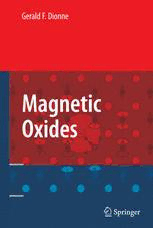
Magnetic Oxides PDF
Preview Magnetic Oxides
Magnetic Oxides Gerald F. Dionne Magnetic Oxides 123 GeraldF.Dionne MassachusettsInstituteofTechnology 244WoodStreet Lexington,MA02420 [email protected] ISBN978-1-4419-0053-1 e-ISBN978-1-4419-0054-8 DOI10.1007/978-1-4419-0054-8 Springer NewYorkDordrechtHeidelbergLondon LibraryofCongressControlNumber:2009935694 (cid:2)c SpringerScience+BusinessMedia,LLC2009 Allrightsreserved.Thisworkmaynotbetranslatedorcopiedinwholeorinpartwithoutthewritten permission of the publisher (Springer Science+Business Media, LLC, 233 Spring Street, New York, NY10013,USA),exceptforbriefexcerptsinconnectionwithreviewsorscholarlyanalysis.Usein connectionwithanyformofinformationstorageandretrieval,electronicadaptation,computersoftware, orbysimilarordissimilarmethodologynowknownorhereafterdevelopedisforbidden. Theuseinthispublicationoftradenames,trademarks,servicemarks,andsimilarterms,eveniftheyare notidentifiedassuch,isnottobetakenasanexpressionofopinionastowhetherornottheyaresubject toproprietaryrights. Printedonacid-freepaper SpringerispartofSpringerScience+BusinessMedia(www.springer.com) Theauthordedicatesthisbookto Rev.HughMcPhee, S.J., formerDean ofScienceat LoyolaCollege inMontreal, who onceadviseda liberalartsstudent thatsciencecouldoffer aclearer window ontheworld. Preface Theinspirationsforthisbookprobablybeganin1961whenIleftapromisingcareer as a semiconductordeviceengineerin the Rte 128 cauldronof the Boston area to pursuea newchallengeatthe McGillUniversityEatonElectronicsResearchLab- oratory.Three yearslater I wrote a Ph.D. thesis on paramagneticresonanceand3 yearsafterIwasaddingtothatexperienceasaStaffMemberwithMITLincolnLab- oratory, where the scope of my obligations gradually broadened from microwave magnetic resonance to the physics and chemistry of ferrites and related magnetic oxidesystems.Atthetimeofthiswriting,Icontinuethereasaresidentconsultant andalsoasa researchaffiliatewith theMITDepartmentofMaterialsScienceand Engineering. Magnetic resonance has played a vital role in the study of magnetism in ox- idesandotherinsulatingcompoundsthatbeganduringWorldWarIIandflourished globallyfora quartercentury.Duringthishalcyonperiod,textsonmagnetismbe- came abundant as many of the pioneers took pen in hand to leave a treasure of elegantly presented reference literature as the 1960s drew to a close. By the mid- 1970s, the once-fledglingfield of semiconductorelectronicsthat I had abandoned wasoverwhelmingalmostallcompetingtechnologies,includingthosewithamag- netic component. For the better part of the two decades between the end of the Vietnam war and the discoveriesof high-temperaturesuperconductivityand giant magnetoresistanceintransition-metaloxidesintheearly1990s,fundamentalinves- tigationsofmagneticcompoundswerenearlydormant. Thecontentandorganizationofthisvolumeareintendedtoservetwopurposes: (1) bridging of the intellectual gap left by the 20 years of reduced inquiry into magnetic phenomena, and (2) restoration of the molecular approach to the study ofmagneticinsulatorsthatfunctionmorebylocalratherthanthecollectiveelectron interactionsthataremorecharacteristicofmetalsandsemiconductors. Thelevelofdiscussionpresumesthereadertohavesomefamiliaritywithatomic physicsandbasic quantummechanics.Chapter1isanabbreviatedintroductionto magnetism.Thediscussionbeginswithareminderofsomefundamentaldefinitions and selected subjectsthatcan be foundin moststandardtextbooks.However,two topicsaretreatedingreaterdepth.Agenericdescriptionofthequantumoriginsof magneticexchangeintroducestheantisymmetryrequirementsofthehybrideigen- states that determine the stabilization of parallel (metal) or antiparallel(insulator) vii viii Preface spin alignment. This general theory is intended to support the later discussion of superexchange that is approached with a model that is more specific to magnetic oxides.Anintroductiontomagneticresonanceandrelaxationderivedfromclassical Larmorprecessionservesasimilarpurposefortheexaminationofthebroadsubject ofelectromagnetisminferrites.The physicsandchemistryofmagnetisminoxide compoundsiscoveredinChaps.2,3,and4intermsoflocalizedionandmolecular- orbitalmodelsofmolecularbonding.Chapter5addressesthesecondarymagnetic phenomenaofanisotropyandmagnetostrictionfromthestandpointoflocalorbital interactions with crystal fields and spin–orbitcoupling that producesself-induced magnetoelastic effects. Traditional phenomenological theories are then reviewed in preparation for the examination of electromagnetic properties in Chap. 6. In Chaps. 7 and 8, magneto-optics and polarized spin transport that will be of in- creasing importance in the age of molecular-scale structures are described in the conceptualcontextoftheearlierchapters. As the preparationof this monographdrawsto a close, I reflecton the journey that brought me to this point. From the frequency of their citations, the reader is certaintorecognizetherelianceontheseminalworksofJohnVanVleck,Maurice Pryce,JohnGoodenough,andErnstSchlœmann,aswellastheclassictextbooksof AlanMorrish,SoNshinChikazumi,CarlBallhausen,BenjaminLaxandKennethBut- ton,andmanyothers.Therewerealsocollaborationswithacademia,industry,and governmentthat are too numerousto list in anydetail. However,I cannotpass up thisopportunitytoacknowledgetheguidanceofmydoctoralthesisadvisorGarnet WoontonandhiscolleagueMauricePrycewhowasamostencouragingexternalex- aminer.LincolnLaboratory’sradarleadersJohnAllen,CarlBlake,DonaldTemme, and Roger Sudbury who supported me and my vigorouscolleagues Jerald Weiss, JamesFitzgerald,DanielOates,andRussellWest(ofTrans-Tech,Inc.).Thenthere was the mentorshipof JohnGoodenoughandBenjaminLax andthe MIT campus affiliationswithMildredandGeneDresselhaus,andCarolineRoss.Finally,Imust mentiontheassociationswithKristlHathaway,GaryPrinz,andStuartWolfofthe USDepartmentsof theNavyandDARPA, andthe assistance ofElaineThamand LaurenDanahyofSpringerUS. Lexington GeraldF.Dionne MA Contents 1 IntroductoryMagnetism...................................................... 1 1.1 FundamentalConceptsandDefinitions ............................... 1 1.1.1 BasicElectrostatics............................................. 2 1.1.2 BasicMagnetostatics........................................... 3 1.1.3 DemagnetizationinUniformlyMagnetizedBodies.......... 4 1.1.4 DomainsinPartiallyMagnetizedBodies ..................... 6 1.2 InducedMagnetism..................................................... 8 1.2.1 DiamagnetismandParamagnetism............................ 8 1.2.2 TemperatureDependenceofSusceptibility................... 11 1.3 SpontaneousMagnetism ............................................... 15 1.3.1 ClassicalFerromagnetismandAntiferromagnetism.......... 15 1.3.2 SolutionsoftheBrillouin–WeissEquation ................... 16 1.3.3 QuantumOriginsoftheMolecularField ..................... 19 1.3.4 TheIsingApproximation...................................... 24 1.4 Gyromagnetism......................................................... 25 1.4.1 LarmorPrecessionandResonance............................ 26 1.4.2 PhenomenologicalRelaxationTheory ........................ 27 1.4.3 ComplexSusceptibilityTheory................................ 29 1.4.4 ResonanceLineShapes........................................ 33 Appendix1A Spin–LatticeContributiontoLinewidth ..................... 34 References....................................................................... 35 2 MagneticIonsinOxides ...................................................... 37 2.1 TheTransitionMetals.................................................. 37 2.1.1 ThePeriodicTable ............................................. 38 2.1.2 IronGroup3dnIons........................................... 40 2.1.3 RareEarth4fn Ions............................................ 42 2.1.4 4dnand5dnIons.............................................. 42 2.2 OxygenCoordinations ................................................. 43 2.2.1 CrystalSystemsandPointGroups ............................ 44 2.2.2 CubicSymmetry ............................................... 45 2.2.3 LowerSymmetries............................................. 47 2.3 CrystalElectricFields.................................................. 48 2.3.1 AngularMomentumStates .................................... 49 ix x Contents 2.3.2 CrystalFieldHamiltonian ..................................... 50 2.3.3 HierarchyofPerturbations..................................... 54 2.3.4 Weak-FieldSolutions .......................................... 55 2.3.5 GroupTheoryandLowerSymmetry.......................... 64 2.3.6 StrongFieldSolutionsandTermDiagrams................... 68 2.3.7 Rare-EarthIonSolutions....................................... 71 2.4 OrbitalEnergyStabilization ........................................... 73 2.4.1 One-ElectronModel ........................................... 73 2.4.2 High-andLow-SpinStates.................................... 75 2.4.3 Orbit–LatticeStabilization(Jahn–TellerEffects)............. 79 2.4.4 Spin–Orbit–LatticeStabilization .............................. 82 2.5 CovalentStabilization.................................................. 88 2.5.1 Molecular-OrbitalTheory...................................... 89 2.5.2 DeterminantMethod........................................... 91 2.5.3 (cid:2) and(cid:3) BondsandtheMolecularOrbitalDiagram.......... 95 2.5.4 ValenceBondMethod.......................................... 99 Appendix2A HomonuclearMoleculeIon...................................102 Appendix2B Valence-BondDiatomicMolecule ...........................103 References.......................................................................105 3 MagneticExchangeinOxides................................................107 3.1 InterionicMagneticExchange.........................................108 3.1.1 Molecular-OrbitalExchangeApproximation.................109 3.1.2 Valence-BondSolutions .......................................113 3.1.3 SpinAlignmentinOxides .....................................119 3.1.4 FerromagnetismbySpinTransfer.............................121 3.1.5 Goodenough–KanamoriRules.................................125 3.2 Antiferromagnetism....................................................129 3.2.1 SuperexchangeandMolecularFields .........................129 3.2.2 MolecularFieldTheoryofAntiferromagnetism..............131 3.2.3 AntiferromagneticSpinConfigurations.......................135 3.3 AntiferromagneticOxides..............................................139 3.3.1 One-MetalOxides..............................................139 3.3.2 ABO andA BO Perovskites...............................140 3 2 4 3.3.3 TheMixed-ValenceManganiteAnomaly.....................143 Appendix3A AnalysisofM2CO2(cid:2)ExchangeInteractions................146 Appendix3B CurieTemperatureModelfor(La,Ca)MnO ................147 3 References.......................................................................149 4 Ferrimagnetism................................................................151 4.1 FerrimagneticOrder....................................................151 4.1.1 GenericFerrimagneticSystems ...............................152 4.1.2 MolecularFieldTheoryofFerrimagnetism...................153 4.1.3 MagneticFrustrationandSpinCanting.......................157 Contents xi 4.2 TheoryofSuperexchangeDilution....................................161 4.2.1 SuperexchangeEnergyStabilization..........................161 4.2.2 MolecularFieldCoefficients...................................164 4.2.3 SolutionforYttriumIronGarnet..............................165 4.3 FerrimagneticOxides...................................................168 4.3.1 SpinelFerritesAŒB (cid:4)O ......................................169 2 4 4.3.2 GarnetFerritesfc gŒa (cid:4).d /O .............................175 3 2 3 12 4.3.3 Rare-EarthGarnetFerrites.....................................180 4.3.4 Rare-EarthCantingEffect .....................................184 4.3.5 HexagonalFerrites .............................................190 4.3.6 Orthoferrites....................................................193 Appendix4A MolecularFieldAnalysisofLiZnTiFerrite .................193 Appendix4B High-MagnetizationLimits...................................195 Appendix4C BrillouinFunctionsinExchangeEnergyFormat............196 References.......................................................................197 5 AnisotropyandMagnetoelasticProperties.................................201 5.1 QuantumParamagnetismofSingleIons ..............................202 5.1.1 TheoryofAnisotropicgFactors...............................202 5.1.2 ConventionalPerturbationSolutions..........................205 5.1.3 TheSpinHamiltonianfor3dnIons ...........................209 5.1.4 TheCrystal-FieldHamiltonianfor4fn Ions..................210 5.2 AnisotropyofSingleIons..............................................212 5.2.1 3d1and3d6D-StateTriplet..................................213 5.2.2 3d4and3d9D-StateDoublet(J–TEffect)...................217 5.2.3 3d2and3d7F-StateTriplet...................................219 5.2.4 3d3and3d8F-StateSinglet...................................220 5.2.5 3d5S-StateSinglet.............................................222 5.2.6 4fn IonAnisotropy............................................226 5.3 MagnetocrystallineAnisotropyandMagnetostriction................228 5.3.1 PhenomenologicalAnisotropyTheory........................229 5.3.2 PhenomenologicalMagnetostrictionTheory .................231 5.3.3 DipolarPairModelofMagneticAnisotropy..................234 5.3.4 Single-IonModelofFerrimagneticAnisotropy ..............236 5.3.5 CooperativeSingle-IonEffects:Anisotropy..................241 5.3.6 CooperativeSingle-IonEffects:Magnetostriction............246 5.4 MagnetizationProcessandHysteresis.................................250 5.4.1 InitialPermeabilityandCoercivity............................251 5.4.2 AnisotropyFieldandRemanenceRatio.......................254 5.4.3 ApproachtoSaturation ........................................256 5.4.4 DemagnetizationandPermanentMagnets....................258 Appendix5A Four-LevelDegeneratePerturbationSolution ford1....................................................................261 xii Contents Appendix5B T Solutionford1inanExchangeField....................263 2g Appendix5C OrbitalStatesofd5inaCubicField.........................265 Appendix5D AngularDependenceofCubicAnisotropyFields...........267 References.......................................................................269 6 ElectromagneticProperties...................................................273 6.1 MagneticRelaxation ...................................................274 6.1.1 NonresonantLongitudinalRelaxation ........................274 6.1.2 QuantumMechanismsofSpin–LatticeRelaxation...........278 6.1.3 PerturbationTheoriesofSpin–PhononInteraction...........286 6.2 GyromagneticResonanceandRelaxation.............................287 6.2.1 ParamagneticResonance.......................................288 6.2.2 FerromagneticResonance .....................................292 6.2.3 UniformPrecessionDamping .................................295 6.2.4 InhomogeneousResonanceLineBroadening.................297 6.2.5 Fast-RelaxingIonEffects......................................300 6.2.6 TheExchangeIsolationEffect.................................306 6.3 Exchange-CoupledModes(SpinWaves)..............................307 6.3.1 UniformPrecessionDecoherence(Degenerate SpinWaves) ....................................................307 6.3.2 InstabilityThreshold(ClassicalApproximation).............311 6.3.3 InstabilityThreshold(NonlinearSpinWaves)................315 6.3.4 MagnetostaticModes ..........................................317 6.4 PermeabilityandPropagation..........................................318 6.4.1 Low-FrequencyLongitudinalPermeability...................318 6.4.2 High-FrequencyTransverseLimits............................322 6.4.3 Snoek’sLawConsiderations...................................324 6.4.4 CircularPolarizationandNonreciprocalProperties..........327 6.4.5 LinearPolarizationandFaradayRotation.....................332 Appendix6A TransversePermeabilityTensor..............................333 Appendix6B ClassicalInstabilityThreshold ...............................336 Appendix6C DomainWallSusceptibilityEquation........................338 References.......................................................................340 7 Magneto-OpticalProperties..................................................343 7.1 InfraredExchangeResonance .........................................344 7.1.1 ClassicalPrecessionModel....................................344 7.1.2 QuantumSpinTransitionModel ..............................346 7.1.3 ExperimentalExchangeSpectra...............................351 7.2 CombinedPermeabilityandPermittivity..............................352 7.2.1 The["](cid:2)[(cid:5)]TensorSolutions..................................352 7.2.2 PropagationParametersandFaradayRotation ...............353 7.3 Magneto-OpticalSpectra...............................................355 7.3.1 Electric-DipoleTransitions....................................355 7.3.2 YttriumIronGarnetSpectra(Paramagnetic) .................360
